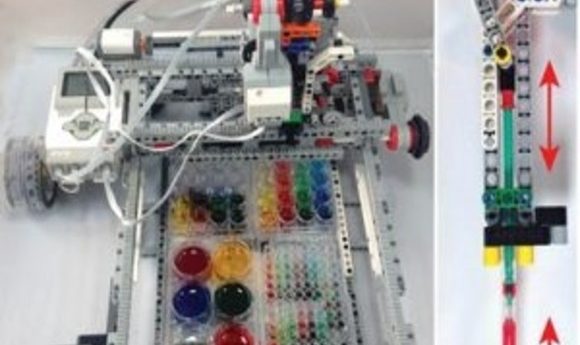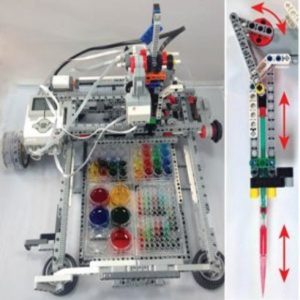The perfect lab technician is a robot!

Playing with LEGO bricks and robots could end the pipetting woes of researchers.

The 2-D liquid-handling robot handling 4 multi-well plates and the liquid dispensing crankshaft of the pipettor.
Credit: Riedel-Kruse Ingmar
During a long day at work, researchers may be busy writing papers, lagging behind with their planned experiments, and struggling to keep their cells alive. Often, they need a distraction, but not one that takes them too far away from their work. Riedel-Kruse Ingmar and his team at Stanford University may have the perfect solution: building LEGO-based liquid handling robots.
Writing in Plos Biology, Ingmar and his team describe the designs of robots to aid research and education. The team built a basic robotic pipettor that dispenses liquid through a motorized syringe bearing a 1-ml pipette tip into cuvettes lined up in a row on a trolley.
The team chose LEGO blocks because of their accessibility for use in schools and ease of assembly, using the Lego Education EV3 set for their pipettor. “We tried to make a design that people can use exactly those pieces [from the kit] and no other piece to build the robot,” said Ingmar.
The researchers also developed an advanced 2-D robot that could slide both horizontally and vertically over sample-holders. The liquid-dispensing mechanism efficiently handles sub-microliter liquid volumes stably over 1000 pipetting cycles. The team demonstrated application of this pre-programmable robot for pipetting liquids in and out of multi-well plates, which are commonly used in biological assays.
“This would easily save me 2 hours worth of my time each day to do something else,” said Saumyaa, a postdoctoral fellow at the Stanford School of Medicine, who was not involved in this work.
Ingmar envisions applications for these robots in biotechnology and is currently working to increase the precision of handling small liquid volumes and enable the robots to discard contaminated tips. Soumyaa would like to see a multichannel pipettor to speed up the experiments. She added that cost efficiency of advanced versions of the robots will also be an important factor influencing their popularity, especially in smaller labs.
Ingmar and his team do not plan to develop the liquid-handling robots for commercial purposes. However, he encourages researchers and teachers to disseminate this design for developing low-cost applications for research and education. “The idea is to bridge robotics and life sciences,” he said. “The hope is that it will bring together those that are more excited about robotics to become excited about biology and vice versa.”